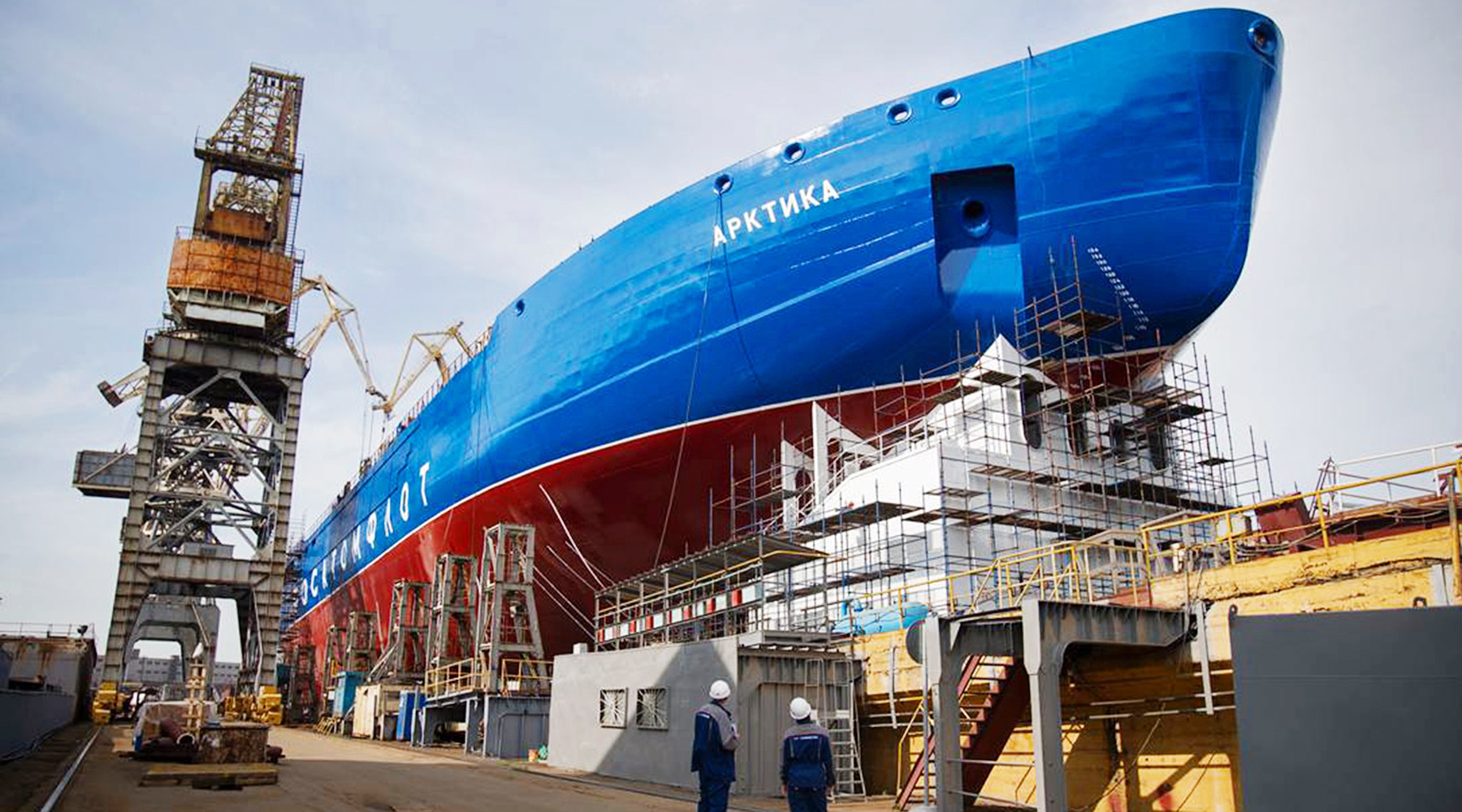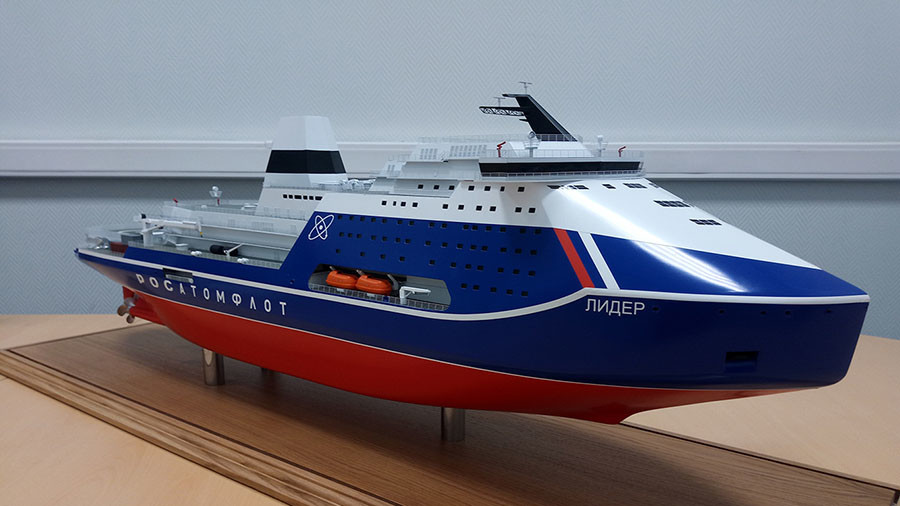Head of the development of the Northern Sea Route (NSR) and the coastal areas of Rosatom State Corporation Maxim Kulinko said that Russian industry will build a total of five nuclear icebreakers of the project 22220 (type LC-60Ya) to provide year-round navigation in the Arctic.
“A decision has already been made to build the third, fourth and fifth icebreakers of project 22220. We plan to enter into a contract next year,” said Kulinko, speaking on December 5 at the VII International Forum “The Arctic: Present and Future” in St. Petersburg.
Project 22220 ships should replace the Soviet generation of the nuclear icebreakers of the project 10520 and project 10580. Currently, four nuclear icebreakers are in operation: the Yamal, 50 Years of Victory, Taimyr and Vaigach. In 2019, Russia is to receive the nuclear-powered nuclear project “Arktika”, in 2020 - Siberia, and in 2022 — Ural.
According to Kulinko, for the construction of icebreakers of the project 22220, the “mixed financing” scheme will be applied for the first time. The state will allocate 50% of the required amount, the remaining money "will be added from the own funds of the state corporation and attracted from the market." The top manager of Rosatom stressed that without the formation of a “powerful icebreaking group” it is impossible to effectively develop the NSR.

- The head nuclear icebreaker “Arktika” of project 22220 at the shipyard LLC “Baltic Plant - Shipbuilding” in St. Petersburg
- RIA News
- © Nikita Gradin
“The state corporation has taken measures to extend the operating life of existing ships. But as a whole, the general concept is that by 2035 the icebreaking fleet should include five universal nuclear icebreakers with a capacity of 60 MW (project 22220), three Leader icebreakers, four gas-powered icebreakers with a capacity of up to 40 megawatts, one icebreaker "50 years Victory ", whose resource will be exhausted by 2039," said Kulinko.
Rosatom is the single infrastructure operator of the Northern Sea Route. The corporation is engaged in state property management, is responsible for the construction and repair of ships, as well as the modernization of the coastal infrastructure.
Traffic growth
The Northern Sea Route is the shortest route from East Asia to Europe with a length of about 10 thousand km. During the summer navigation period, the route of ships in the EU via the NSR is about three weeks, while cargo delivery via the Suez Canal (the most popular route in the world) takes at least a month with a length of 20 thousand km.
As expected in Rosatom, in 2018 the cargo traffic through the SPM will reach 18 million tons. In 2017, this figure was 10 million tons, becoming a record in the history of Russia, including the Soviet period. In 2019, 29 million tons of cargo are planned to be transported across northern latitudes, in 2024 - 63 million tons, in 2030th - 80 million tons.
According to the Ministry of Natural Resources, 96% of cargo transported across the Arctic Ocean consists of liquefied natural gas (LNG), oil, petroleum products, coal, mineral fertilizers, 4% - building materials and various industrial equipment.
Currently, the main driver of the Northern Sea Route is the project for the construction of plants for the liquefaction of natural gas in the Yamalo-Nenets Autonomous District (YaNAO), which is being implemented by PJSC Novatek. The volume of LNG production in 2019 can reach 18 million tons, and in 2025 - 44 million tons. Most Novatek products are exported.
To ensure uninterrupted transportation along the Northern Sea Route, the Russian government plans to modernize the infrastructure of 16 Arctic and Far Eastern ports by 2024.
For example, a large transshipment hub will be located in the Murmansk region to transport hydrocarbons and minerals to Europe. In particular, the capacity of the operating coal terminal should increase by 4.5 million tons, and the creation of an LNG road terminal will allow transporting up to 20.8 million tons of this energy carrier.

- Production complex "Yamal LNG"
- © yamallng.ru
"On the difficult paths"
However, the most important task of the government is the construction of icebreakers and, above all, nuclear. The greatest hopes are placed on the project 10510 “Leader” (type LK-120Ya). These ships should provide year-round navigation on the most difficult, eastern section of the NSR. Now the navigation period there is limited to 3-4 months.
Operation of the Leader will allow tankers and gas carriers carrying cargo weighing over 100 thousand tons across the Arctic Ocean. For the safe passage of such large commercial vessels, a corridor about 50 m wide is required. The current nuclear icebreaking fleet of the Russian Federation is capable of creating a channel not exceeding 34 m wide. In addition, the “Leaders” will lay deep-water routes in the mouths of Siberian rivers.
According to the leader developer of the Leader CDB Iceberg, the displacement of the ship will be 71.2 thousand tons, length - 209 m, width - 47.7 m, draft - 13 m. The power of the nuclear power plant on the screws will reach 120 MW. JSC "Afrikantov OKBM" (Nizhny Novgorod) will create this unique super-power reactor.
The Leader will be the world's largest icebreaker with unlimited cruising range. According to the calculations of Iceberg Central Design Bureau, the autonomy of the ship of the project 10510 will be 8 months, the ice passing capacity is up to 4.3 m. The cost of one nuclear-powered ship is estimated at 70 billion rubles by the United Shipbuilding Corporation.
In September, Deputy Prime Minister Yury Borisov announced that the Far Eastern shipyard Zvezda (Bolshoy Kamen) and the Baltic Shipyard (St. Petersburg) will be building the Leaders. According to him, the issue of financing the project 10510 has been resolved positively. Russian enterprises will build three icebreakers, but Borisov did not specify the time for laying the lead ship.

- Project of the nuclear icebreaker "Leader"
- © iceberg.sp.ru
In a conversation with RT, the director of the Arctic and Antarctic Research Institute, Doctor of Geographical Sciences, Ivan Frolov, said that the “Leader” would be able to carry out caravans of ships “along difficult roads, regardless of the state of the ice.”
“The Northern Sea Route passes through the water area with harsh natural and climatic conditions. Nevertheless, the cargo traffic in the NSR is growing at an explosive pace and, apparently, in the very next few years it will reach 50 million tons. With such dynamics, Russia will need at least three or four icebreakers of the project 10510. However, the “Leader” is a complex project: simultaneously with the commissioning of these icebreakers, it is necessary to prepare the infrastructure for their service, ”Frolov explained.
Director of the Museum of the Arctic and Antarctic, Candidate of Physical and Mathematical Sciences Victor Boyarsky stressed in a conversation with RT that the “Leader” will allow to provide full navigation through the NSR in accordance with the requirements of commercial traffic, which are “very tied to the schedule.”
“The current icebreaker ice-breaking capacity is 2-2.5 meters. It does not suit commercial shipments. The “leader” will serve the eastern sector of the Arctic, as more difficult in ice terms, and less powerful icebreakers will continue to operate in the western sector. The situation is such that even one “Leader” would have already solved many problems, ”concluded Boyarsky.
